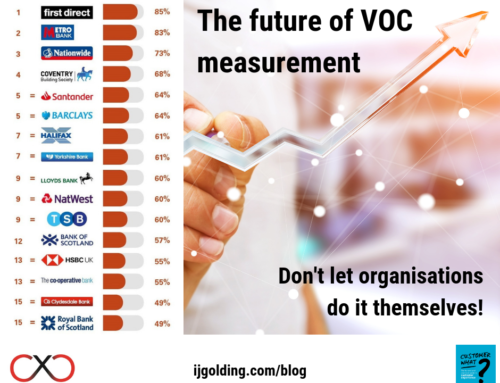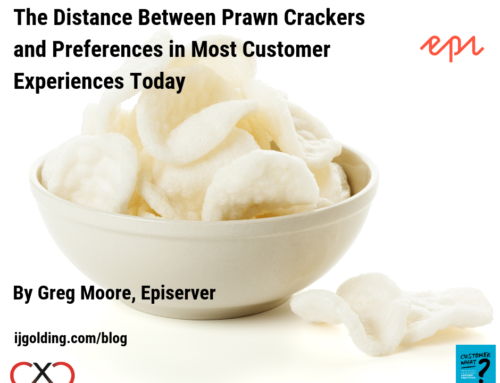Customer experience is important, that much we know.
Readers of this blog won’t need persuading of the link between a company’s success and a great customer experience.
Happy customers stay longer, buy more, they tell their friends, and your company grows.
But let them down and your revenue shrinks instead.
Knowing what to do is seriously valuable.
So with the future health of the business at stake, it’s worth knowing how to keep each customer, and that’s where customer feedback comes in.
Customer feedback holds the promise of telling you exactly what you need to do to retain an existing customer, just as a good sales person will find out exactly what’s needed to close the sale for each new customer.
But there’s a big problem with the way customer feedback and satisfaction surveys have traditionally been done which means they don’t deliver this enormous benefit.
Customer feedback is broken.
In fact it’s worse than that. Sometimes the way companies collect feedback actually impairs the customer experience it’s intended to improve.
How do you feel about it? Do you like long surveys? Do you like being pestered with reminders? Do you like surveys which get longer as you fill them in, always asking for more reasons why you gave a good score or a bad score? Do you wonder whether anybody actually reads your cry for help? Have you ever, I mean ever, mentioned a problem and had someone follow up quickly to put things right?
If you have it’s definitely the exception not the norm.
So customer feedback is not delivering on its huge potential to increase satisfaction and drive revenue up, because it’s not improving the experience of the people who respond. By the time action is taken (if any is taken at all) the customers who told you about a problem will have gone and their precious lifetime value, which could have been retained, is instead lost.
And the bad news doesn’t end there. These people who could have been singing your praises if you’d got this process right are instead warning others to stay away based on their poor experience – the fact you didn’t respond to their problem when they told you clearly what it was.
It’s remarkable how many great brands do a fabulous job in other areas of the customer’s experience, but have a huge blind spot when it comes to the way they collect and manage customer feedback.
How a fresh approach to customer feedback drives growth.
The good news is that the problem is easy to fix. It doesn’t require more resource, though you might need to deploy some people differently, and it needn’t incur extra investment.
The answer is not to design better surveys. That’s certainly a good thing to do, but the poor survey experience is a symptom of the problem not its underlying cause.
No, the key is to think about the whole process of customer feedback differently.
You need to start again and design your customer feedback process from the customer’s point of view.
Putting it another way, if you’re benefiting from customer journey mapping, don’t forget to map, understand and fine tune the feedback touchpoints of the journey too.
Start by understanding the appropriate response to feedback.
The first part of the solution is to understand that there are different types of feedback that customers want to give, and they expect you to handle them appropriately.
1. Positive feedback – praise.
Sometimes customers just want to thank you for doing a great job. One of your team nailed it today, and they should get the proper recognition.
So positive feedback is best circulated to everyone. Your people all come to work wanting to do a good job for customers, and it’s tremendously motivating when they read words from customers giving them credit for a job well done. It spurs them on to keep up the good work and promotes best practice.
2. Negative feedback – generic to all customers
This is where an improvement is needed to your products, services, systems, processes, policies or people’s behaviours.
The appropriate response is to examine the accumulated data, prioritise improvements, then put in place a plan to implement the changes.
The characteristic here is that the improvement will benefit all your customers. But because it requires change, the improvement is likely to take time. Then you need to tell customers what you’ve done. Learning and improving like this is a good thing to do, but it’s not the complete answer.
It’s a near universal mistake that companies assume all feedback falls into this category and should be dealt with this way.
It’s a mistake because this type of feedback doesn’t deliver the biggest or fastest benefits.
And it’s a mistake because the type that does deliver the biggest benefits requires a completely different response.
3. Negative feedback – specific to an individual customer
This is the feedback that happens when something has gone wrong for an individual and it’s where the real treasure is found.
In this case something has gone wrong for an individual customer and they’re feeling acute pain and frustration right now.
Fix it quickly, and you’ll blow their socks off, because nobody else does this. Even if you can’t fix it immediately, responding quickly and personably will impress them. And they’re much more likely to tell others.
This is not our normal experience after giving feedback, yet it is the one we yearn for.
Note the shocking contrast between the traditional approach to feedback and the customer-centric approach. One approach loses a customer who drags your reputation down. The other keeps a customer who marvels about your remarkable service.
Which approach would you rather experience?
Out with the old and in with the new.
You can change feedback from an ordeal into a great experience for customers by following a refreshingly simple and commonsense approach based on three principles.
- Collect feedback at the times when a customer is most likely to want to give it.
- Make it impressively fast and easy. Aim for 20 seconds or less.
- Think about what a customer hopes will happen when they’ve given feedback. Most importantly, act on the feedback appropriately, and immediately if necessary.
By embedding customer feedback into ‘business as usual’ processes and collecting it in real time you create the opportunity for service recovery when the customer reports a concern. That means you discover who’s at risk, immediately, and you know exactly what’s required to save them.
Of course, this means that it’s flawed thinking to outsource measurement of customer satisfaction, or to have the results go only to silos of analysts or marketers and not to operational roles.
This approach is often called ‘transactional feedback’ but it doesn’t reduce your ability to measure loyalty nor to use the aggregated feedback to identify where generic improvements are required.
It does need fresh thinking and it does need courage not to copy the big brands we usually admire, but who in this area get it so badly wrong. It requires a company culture that genuinely and instinctively links customer experience with future prosperity, and in addition to an improved feedback process it needs not a larger team, but a different mix of roles and responsibilities.
Incremental revenue and profit.
I was responsible for service revenue in a large company when I learnt this approach and it took me four years to master it, even though in hindsight it’s remarkably simple.
But the benefit from eliminating avoidable customer losses was substantial.
For every ten customers who were leaving us at the outset, we reduced it to the four losses that were unavoidable.
Reducing attrition in this way by 60% increased our profitability by 23%, and it cost us next to nothing.
Tips to make it easier.
You can apply these principles to whatever method you choose to measure customer satisfaction. If you make phone calls to your customers that’s just fine, the same rules apply and the same benefits are achievable.
Medium and large organisations will want to use software so be careful to choose a platform that helps rather than hinders the best approach:
- Choose a vendor which is demonstrably expert in customer experience, not just technology.
- Choose software which places more emphasis on features that help you action feedback, rather than on features which help you collect it, because it’s the follow-up not the measurement that delivers the value.
Guy Letts led customer service at a FTSE 100 company before founding CustomerSure in 2010. Hundreds of medium to large companies now rely on CustomerSure’s award winning customer experience software to measure and improve customer satisfaction and retention.
My book, ‘Customer What? – the honest and practical guide to customer experience’ – is now available to purchase! You can do so on Amazon.com or Amazon.co.uk. If Amazon does not ship to your part of the world, please complete the form found here and I will arrange an alternative method to ship a book to you. Enjoy the read!!








Great insights, Ian! Another way to complement customer feedback is to analyze customer behavior – by (securely!) harnessing your historical support data. We recently published a blog on how you can use AI to do this systematically, leveling up your CX in the process:
https://www.ultimate.ai/blog/ai-automation/what-is-a-feedback-loop